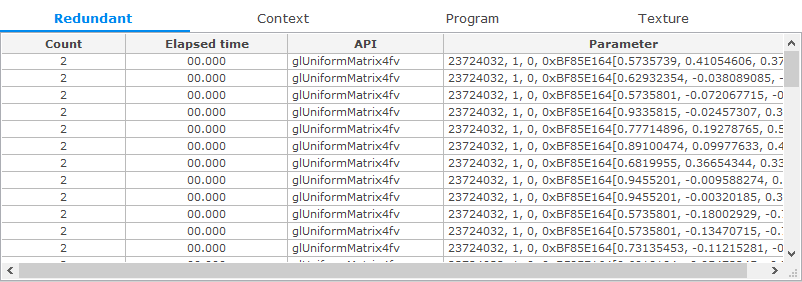Performing OpenGL Analysis
PUBLISHED
The OpenGL ES (Open Graphics Library) tab of the Dynamic Analyzer displays information about OpenGL® 2.0 and EvasGL.
The tab consists of the following views:
- OpenGL chart shows the elapsed time of the frame.
- Statistics table displays statistics of APIs related to EvasGL and OpenGL®.
- API List table shows the OpenGL® APIs that are associated with the values selected in the OpenGL chart.
- Redundant table displays the APIs that are called repeatedly with the same parameters.
- Context table displays the render state of the API context selected in the API List table.
- Program table shows the shader program information.
- Texture table shows texture information.
Figure: OpenGL analysis

OpenGL Chart
The OpenGL chart displays the elapsed frame time with 2 charts:
- The Frame time chart shows the elapsed frame time. The X axis value of the frame time chart is the frame index number. A smaller chart value indicates a better status frame. Only frames smaller than the value specified by the user and changed to yellow are visible.
Figure: Frame time chart

- The Frame rate chart shows the FPS. The X axis value of the frame rate chart is the analysis time. A larger chart value indicates a better status frame.
Figure: Frame rate chart analysis

Statistics
The Statistics table displays the API statistics related to EvasGL and OpenGL® 2.0.
Figure: Statistics table

The table contains the following columns:
- API (text): API name
- Time rate (long): Rate of the API that was called
- Count (integer): Number of times the API was called
- API type (text): What the API operates on and how
API List
The API List table displays the APIs associated with the values selected in the chart.
Figure: API List table

The table contains the following columns:
- # (integer): Unique log index
- Frame: Frame index number
- Time (time): Time when the API was called
- API (text): API name
- Parameter: Input parameter of the API
- Return: Return value of the API
- Elapsed time (time): Time to return after the call
- Error (text): Error description of the API; a normal end return is GL_SUCCESS
- PID (integer): API process ID
- TID (integer): API thread ID
Redundant
The Redundant table displays the APIs that are called repeatedly with the same parameters.
Figure: Redundant table

The table contains the following columns:
- Count (integer): Number of times the API was called
- Elapsed time (time): Time to return after the call
- API (text): API name
- Parameter: Input parameters of the API
Context
The Context table displays the context rendering state associated with the item selected in the API List table. The title of the table refers to the context number of the selected API.
Figure: Context table

The table contains the following columns:
- Name (text): State name
- Default state (text): Initial state value when the program is started
- Current state (text): Current state value
Compare the Default state and Current state values to see the changes. The yellow color represents a changed state.
Program
The Program table displays the program information associated with the items selected in the API List table.
Figure: Program table

The table contains the following columns:
- ID (text): Program ID of the context
- Context ID (text): Context name
- Vertex shader (text): Vertex shader ID of the program
- Fragment shader (text): Fragment shader ID of the program
The same ID cannot be replicated in a context.
Texture
The Texture table displays the textures associated with the item selected in the API List table.
Figure: Texture table

The table contains the following columns:
- Context ID (text): Context name
- ID (text): Texture ID of the context
- Type (text): Render state value of the texture type
- WRAP_S (text): Render state value of the WRAP_S texture
- WRAP_T (text): Render state value of the WRAP_T texture
- MIN_FILTER (text): Render state value of the MIN_FILTER texture
- MAG_FILTER (text): Render state value of the MAG_FILTER texture
